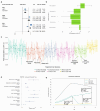This is a preprint.
Genome-wide association study of adolescent-onset depression
- PMID: 41040734
- PMCID: PMC12485989
- DOI: 10.1101/2025.09.26.25335972
Genome-wide association study of adolescent-onset depression
Abstract
Adolescent depression is a heritable psychiatric condition with rising global prevalence and severe long-term outcomes, yet its biological underpinnings remain poorly understood. We conducted the first genome-wide association study of adolescent-onset depression, comprising 102,428 cases (diagnosis or clinical symptom thresholds) and 286,911 controls, including diverse ancestries. Cross-ancestry meta-analysis identified 52 independent variants across 17 loci; European-only analysis found 61 variants at 29 loci, with a SNP-based heritability of 9.8%. Comparative analyses revealed two genes unique to adolescent-onset versus lifetime depression, enriched in neuronal subtypes, and two genes as potential drug repurposing targets. Polygenic scores were associated with adolescent-onset depression across ancestries, persistent depression trajectories, more severe outcomes, as well as reduced cortical volume, surface area and white matter integrity. Genetic correlation and Mendelian randomisation analyses support shared genetic liability and causal links with early puberty and modifiable health and behavioural risk factors. These findings uncover novel genetic loci and refine biological pathways underlying adolescent-onset depression, revealing age-specific mechanisms and early intervention opportunities.
Conflict of interest statement
Conflicts of Interest Robbee Wedow is a research fellow at AnalytiXIN, which is a consortium of health-data organizations, industry partners and university partners in Indiana primarily funded through the Lilly Endowment, IU Health and Eli Lilly and Company. Ian Hickie holds a 3.2% equity share in Innowell Pty Ltd that is focused on digital transformation of mental health services. Pedro M Pan received payment or honoraria for lectures and presentations in educational events for Sandoz, Daiichi Sankyo, Eurofarma, Abbot. Qingqin Li was an employee of Janssen Research & Development, LLC, when this work was conducted and held stocks of Johnson & Johnson, the parental company of Janssen Research & Development, LLC. There is no conflict of interest other than salary received from the company. Henrik Larsson reports receiving grants from TAKEDA and Shire Pharmaceuticals; personal fees from and serving as a speaker for Medice, Shire/Takeda Pharmaceuticals and Evolan Pharma AB; all outside the submitted work. Henrik Larsson is editor-in-chief of JCPP Advances.
Figures






References
-
- Sawyer S. M., Azzopardi P. S., Wickremarathne D. & Patton G. C. The age of adolescence. The Lancet Child & Adolescent Health 2, 223–228 (2018). - PubMed
-
- World Health Organization. Mental health of adolescents. https://www.who.int/news-room/fact-sheets/detail/adolescent-mental-health (2024).
-
- Johnson D., Dupuis G., Piche J., Clayborne Z. & Colman I. Adult mental health outcomes of adolescent depression: A systematic review. Depression and Anxiety 35, 700–716 (2018). - PubMed
Publication types
Grants and funding
LinkOut - more resources
Full Text Sources
